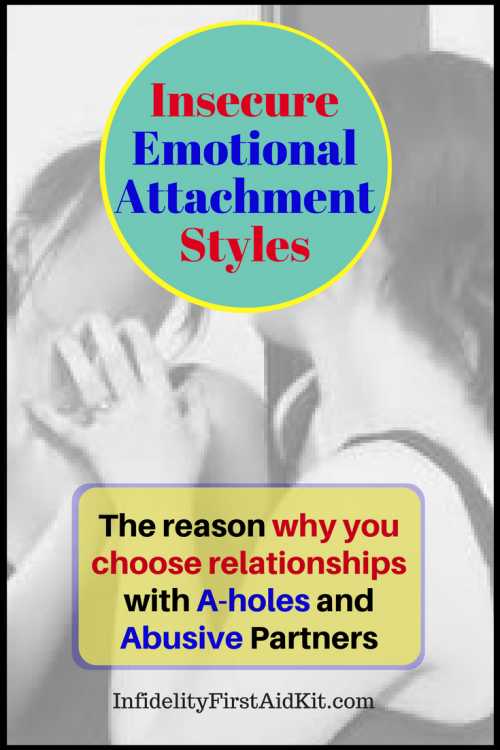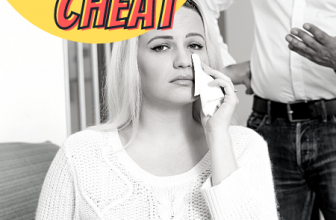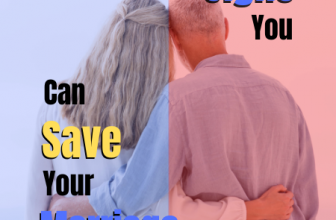
Emotional attachment styles may just answer your question, “What makes people stay in bad relationships?”
Some people pretend to not care when hurt by a partner, others accept disrespect. We all respond to and view relationships differently.
If your partner left you or cheated on you how would you react?
Many of you would do what I did.
I gave my cheating wife (now ex) multiple chances and then still wanted to stay with her.
Looking back that did not favor me at all. And for those who know my story, my first wife (who I cheated on) gave me multiple choices too despite me clearly explaining I had no interest in returning.
At the same time, you will run into people in real life, or through stories online, who either make their disrespectful spouses beg for a pardon. Some even never need worry about mistreatment because their spouses would fear for their lives if they “misbehaved”.
I would say many of us hate the thought of giving up on a relationship we’ve invested so much time growing and nurturing.
The thought of the single life pressures us to stick around even in the most dead-end relationships. In some cases we look past some major character flaws. In others the circumstances simple change, but we ignore those as well.
We know the relationship is over, but we refuse to believe.
So why such difference in the handling of or need for relationships?
The answer could very well be that our emotional attachment styles dictate how we strive for love or repel it, accept mistreatment or refuse to put up with it.
Let’s take a deeper look.
Emotional Attachment Styles in Relationships
- What are emotional attachment styles?
- Why should I know mine?
- How do attachment styles influence toxic relationships?
- How can you determine your style?
- Can you change emotional attachment styles?
(Recap) of the 4 Emotional Attachment Styles
As I mentioned in the previous post on incompatibility, psychologists have identified the following four styles. Of the four kinds one pertains to emotionally stronger people who are secure about themselves. While the others describe many of us who struggle with maintaining long, healthy relationships.
It benefits you to identify which of the emotional attachment styles predominantly describes you best.
Why?
Let’s start with the healthy one.
Secure Attachment Style
If you fit into this style then you tend to be satisfied with your relationships. You feel secure about their partner without jealousy or fear of abandonment.
Secure adults confide in their partner for moral support and console their partner when they feel down. Both partners live their own lives, but communicate with each other honestly without hiding secrets. They form a true connection and do not fake it.
They do not feel a need for their relationship to provide them a false sense of safety to avoid feeling lonely. Secure attachment adults make good listeners because they have empathy for others. They interpret traumatic events as part of a bigger lesson in life instead of feeling sorry for themselves.
Simply put adults who fall into this attachment style category are emotionally strong.
So that describes a healthy person in relationships.
Can attachment styles negatively affect you and keep you stuck in toxic relationships?Let’s look at the insecure attachment styles.
Anxious Preoccupied Attachment Style
People with anxious attachment do not form loving and trusting relationships instead they seek to fill an emotional void. They look to their partners to feel fulfillment and confirmation of being needed, but yet conduct behavior that pushes their partner away and alienates them in a cry for attention.
An anxious preoccupied person acts jealous and fearful when they falsely senses their partner doesn’t love them. Fear of abandonment runs strong in this type of attachment style.
Dismissive Avoidant Attachment Style
Just as unhealthy and insecure as the anxious style the dismissive avoidant detaches themselves from their partner and likes to feel as though they live independently. They tend to focus on themselves, act defensive and lock themselves off from their partner as they fear feeling controlled.
In fights they display the ability to shut down emotionally and not even react- the basic stonewall technique.
This style describes my cheating ex-wife to a “t”.
Fearful Avoidant Attachment Style
Then the fearful avoidant is a hybrid of the other two insecure attachment styles. They neither want intimacy nor detachment from their partner. When overwhelmed with emotions they go through mood swings- unsure how to handle the situation.
In one instant they run and hide, in another they run towards their partner for rescue. Once too close and intimate they may fear disappointment then turn and run away again.
Attachment Style Quizzes- How do you determine which one you are?
You can probably figure out which one you are based on the descriptions above, however, I’ve discovered a more accurate way to pinpoint it.
If you Google “attachment styles quiz” your screen will flood with results.
While I did not check every one I found a free one I did like that you can take right now. (Many quizzes come with a cost.)
I noticed another site referred to this test. So I am not the only one that found some value in it.
Web-research-design.net
This educational attachment style quiz lasts only about 5 minutes and provides and instant response explanation with graph upon completion.
Beware to start the quiz you must answer some demographic questions. This short survey provides information for their research. I’m guessing makes it worth their while to provide the free quiz.
It’s also short which makes me doubt the accuracy, but the evaluation at the end seems pretty thorough.
Click here to take the quiz.
More In-depth Attachment Style Test- [Paid for Self-Test]
If you’d like more information regarding your emotional attachment style then, but don’t mind paying money for a portion of the results then try this one.
It lasts about 20 minutes, 50 questions long and you’ll receive partial results, but pay for the full report. I have not taken this attachment style test yet. I do not know how money they ask for the entire results. If you want answers without going to a therapist then click here to take the test on PsychologyToday.com
Changing Attachment Styles: Can you prevent your emotional attachment style from ruining your relationships?
I’ll go out on a limb and say nobody wants to feel anxious, fearful or stuck in the middle of the two.
So can we change attachment styles?
I can attest that you can. After my last few dysfunctional relationships I shifted from anxious avoidant to fearful/secure avoidant. While I do seek a healthy secure person to meet I no longer seek relationships to complete me. Life’s hardships (pertaining to relationships) forced me to adopt a flexible, open-minded approach to people.
People will act like people. You cannot control them, nor should you try. Treasure whatever experiences you do benefit from them.Still I must work to achieve a 100% secure attachment style.
Resource Suggestion #1 to Change Your Insecure Attachment Style
According to an article by Meghan Laslocky, author of “The Little Book on Heartache”, I found on GreaterGood.Berkeley.edu she offers some simple, easy-to-follow advice for people wrestling with insecure attachment styles.
Meghan lists 5 ways to overcome attachment insecurity. One way is what suggest here on this post. Identify and learn about your attachment style and you can read the other suggestions on her article here.
Living anxious or fearful in relationships is no way to live.
Resource Suggestion #2 to Change Your Insecure Attachment Style
Another article I found by Darlene Lancer, licensed marriage and family therapist, gives you both some action steps and suggested readings.
Darlene believes insecure attachment goes hand-in-hand with codependency. Interestingly anxious and avoidants attract each other since they are less intimidating and more familiar. Of course, this easily can lead to break ups. The anxious quickly look to fill the void with the next dismissive (same as avoidant).
And while she claims most people do not change their attachment style they can learn to alter it by taking action like learning to heal their shame and speaking their minds assertively.
It’s a good detailed article. I suggest reading it if you’d like to discover some tips how to become more secure in your relationships. Darlene offers some resources (along with her own book “Conquering Shame and Codependency“).
Check out the article here.
Summary on the Impact of Attachment Styles on Relationships
Oh how easy it is to point fingers and look outward for the answers to explain our sadness and low self-esteem on the inside, but the truth may lie inside.
Needy, jealous, unfulfilled, fear of abandonment.
Who wants to feel that way in a relationship?
Your partner certainly doesn’t benefit from your insecurity.
If you do not find a way to heal your low self-esteem and insecurities in your relationship then the pattern will last the rest of your life.
How do you expect to enjoy your relationship for any length of time instead of the emotional up-and-down roller coaster ride?
References
- drkeithwitt.com/secure-attachment-in-adults-34/
- psychologytoday.com/blog/compassion-matters/201307/how-your-attachment-style-impacts-your-relationship
- verywell.com/attachment-styles-2795344
- web-research-design.net/cgi-bin/crq/crq.pl

![3-Step Sexting Formula + Text Goddess Scroll [Downloads]](https://www.infidelityfirstaidkit.com/wp-content/themes/rehub-theme/images/default/noimage_336_220.png)


